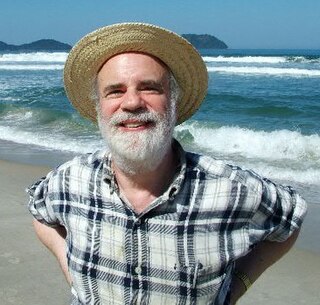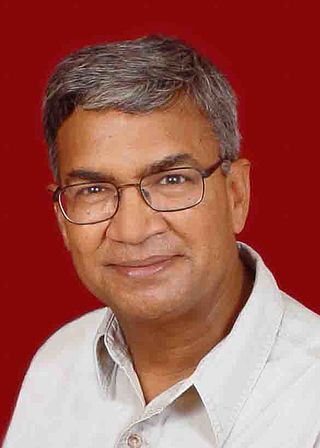Related Research Articles
The Berry paradox is a self-referential paradox arising from an expression like "The smallest positive integer not definable in under sixty letters".
First-order logic—also called predicate logic, predicate calculus, quantificational logic—is a collection of formal systems used in mathematics, philosophy, linguistics, and computer science. First-order logic uses quantified variables over non-logical objects, and allows the use of sentences that contain variables. Rather than propositions such as "all men are mortal", in first-order logic one can have expressions in the form "for all x, if x is a man, then x is mortal"; where "for all x" is a quantifier, x is a variable, and "... is a man" and "... is mortal" are predicates. This distinguishes it from propositional logic, which does not use quantifiers or relations; in this sense, propositional logic is the foundation of first-order logic.
In philosophy and logic, the classical liar paradox or liar's paradox or antinomy of the liar is the statement of a liar that they are lying: for instance, declaring that "I am lying". If the liar is indeed lying, then the liar is telling the truth, which means the liar just lied. In "this sentence is a lie", the paradox is strengthened in order to make it amenable to more rigorous logical analysis. It is still generally called the "liar paradox" although abstraction is made precisely from the liar making the statement. Trying to assign to this statement, the strengthened liar, a classical binary truth value leads to a contradiction.
The propositional calculus is a branch of logic. It is also called propositional logic, statement logic, sentential calculus, sentential logic, or sometimes zeroth-order logic. Sometimes, it is called first-order propositional logic to contrast it with System F, but it should not be confused with first-order logic. It deals with propositions and relations between propositions, including the construction of arguments based on them. Compound propositions are formed by connecting propositions by logical connectives representing the truth functions of conjunction, disjunction, implication, biconditional, and negation. Some sources include other connectives, as in the table below.
Truth or verity is the property of being in accord with fact or reality. In everyday language, it is typically ascribed to things that aim to represent reality or otherwise correspond to it, such as beliefs, propositions, and declarative sentences.

Saul Aaron Kripke was an American analytic philosopher and logician. He was Distinguished Professor of Philosophy at the Graduate Center of the City University of New York and emeritus professor at Princeton University. From the 1960s until his death, he was a central figure in a number of fields related to mathematical and modal logic, philosophy of language and mathematics, metaphysics, epistemology, and recursion theory.

Alfred Tarski was a Polish-American logician and mathematician. A prolific author best known for his work on model theory, metamathematics, and algebraic logic, he also contributed to abstract algebra, topology, geometry, measure theory, mathematical logic, set theory, and analytic philosophy.
The history of logic deals with the study of the development of the science of valid inference (logic). Formal logics developed in ancient times in India, China, and Greece. Greek methods, particularly Aristotelian logic as found in the Organon, found wide application and acceptance in Western science and mathematics for millennia. The Stoics, especially Chrysippus, began the development of predicate logic.
A proposition is a central concept in the philosophy of language, semantics, logic, and related fields, often characterized as the primary bearer of truth or falsity. Propositions are also often characterized as the type of object that declarative sentences denote. For instance the sentence "The sky is blue" denotes the proposition that the sky is blue. However, crucially, propositions are not themselves linguistic expressions. For instance, the English sentence "Snow is white" denotes the same proposition as the German sentence "Schnee ist weiß" even though the two sentences are not the same. Similarly, propositions can also be characterized as the objects of belief and other propositional attitudes. For instance if someone believes that the sky is blue, the object of their belief is the proposition that the sky is blue.

Metamathematics is the study of mathematics itself using mathematical methods. This study produces metatheories, which are mathematical theories about other mathematical theories. Emphasis on metamathematics owes itself to David Hilbert's attempt to secure the foundations of mathematics in the early part of the 20th century. Metamathematics provides "a rigorous mathematical technique for investigating a great variety of foundation problems for mathematics and logic". An important feature of metamathematics is its emphasis on differentiating between reasoning from inside a system and from outside a system. An informal illustration of this is categorizing the proposition "2+2=4" as belonging to mathematics while categorizing the proposition "'2+2=4' is valid" as belonging to metamathematics.
Tarski's undefinability theorem, stated and proved by Alfred Tarski in 1933, is an important limitative result in mathematical logic, the foundations of mathematics, and in formal semantics. Informally, the theorem states that "arithmetical truth cannot be defined in arithmetic".
In philosophy and logic, a deflationary theory of truth is one of a family of theories that all have in common the claim that assertions of predicate truth of a statement do not attribute a property called "truth" to such a statement.
A semantic theory of truth is a theory of truth in the philosophy of language which holds that truth is a property of sentences.
In logic, the semantics of logic or formal semantics is the study of the semantics, or interpretations, of formal languages and natural languages usually trying to capture the pre-theoretic notion of logical consequence.
In logic, the logical form of a statement is a precisely-specified semantic version of that statement in a formal system. Informally, the logical form attempts to formalize a possibly ambiguous statement into a statement with a precise, unambiguous logical interpretation with respect to a formal system. In an ideal formal language, the meaning of a logical form can be determined unambiguously from syntax alone. Logical forms are semantic, not syntactic constructs; therefore, there may be more than one string that represents the same logical form in a given language.
An interpretation is an assignment of meaning to the symbols of a formal language. Many formal languages used in mathematics, logic, and theoretical computer science are defined in solely syntactic terms, and as such do not have any meaning until they are given some interpretation. The general study of interpretations of formal languages is called formal semantics.
Revision theory is a subfield of philosophical logic. It consists of a general theory of definitions, including circular and interdependent concepts. A circular definition is one in which the concept being defined occurs in the statement defining it—for example, defining a G as being blue and to the left of a G. Revision theory provides formal semantics for defined expressions, and formal proof systems study the logic of circular expressions.

Anil K. Gupta is an Indian-American philosopher who works primarily in logic, epistemology, philosophy of language, and metaphysics. Gupta is the Alan Ross Anderson Distinguished Professor of Philosophy at the University of Pittsburgh. He is also a Fellow of the American Academy of Arts and Sciences. His most recent book, Conscious Experience: A Logical Inquiry, was published by Harvard University Press in 2019.
This is a glossary of logic. Logic is the study of the principles of valid reasoning and argumentation.
References
- ↑ Künne, Wolfgang (2003). Conceptions of truth . Clarendon Press. p. 18. ISBN 978-0-19-928019-3.
- ↑ H. Kotlarski, Full Satisfaction Classes: A Survey (1991, Notre Dame Journal of Formal Logic, p.573). Accessed 9 September 2022.
- ↑ Heath, Joseph (2001). Communicative action and rational choice. MIT Press. p. 186. ISBN 978-0-262-08291-4.